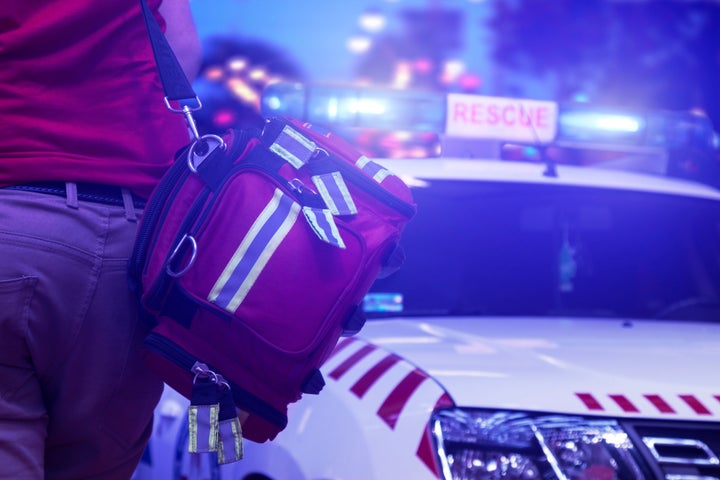
According to the latest available report conducted by the National Emergency Medical Services, from 2011, there are estimated to be more than 826,000 EMS professionals working in the United States. This includes paramedics, emergency medical technicians (EMTs) and first responders, both volunteers and paid workers.
Behind the scenes, EMS workers answer over a thousand emergency calls a year and constantly put themselves in danger in order to save lives. They’re often the first and sometimes the last faces patients see after traumatic events, from fires to mass shootings to accidents. We’ve partnered with Dignity Health to highlight some of the many faces out there saving lives and spreading humankindness every day.
Bill Rothschild, 51, Somers, New York
When a 17-year-old male got hit by a drunk driver in Westchester County, NY, Bill Rothschild was on the scene. Having worked as a paramedic for over three decades, he’d seen a fair share of car accidents, but this was different. “This was a young boy, barely driving age, just running an errand. He wasn’t doing anything illegal, and the scene was brutal,” Rothschild said. As he approached the vehicle, he noticed the teen was losing a large amount of blood quickly.
During impact, the driver had received a massive head wound and face laceration stretching from his ears to his lips. The wound was so large that Rothschild could see his partner through the other side of the young man’s face. Once the fire department arrived, they immediately used their hydraulic rescue tools to remove the teenager from the vehicle and prep him for the ambulance crew. Rothschild felt sure that he wouldn’t make it in time.
His team phoned for a helicopter to fly the patient directly to the trauma center, but before it came, Rothschild had to make a fast decision. If he was going to try to save the teen’s life, he had to get creative. Rothschild wheeled the patient to the helicopter crew who immediately performed a rapid sequence intubation to induce the patient into unconsciousness. The helicopter then took off for the hospital.
“When we fail, everybody notices; when we succeed it goes unnoticed…It’s a battle, it’s a war to bring these people back. You’re using every tool in your toolbox to bring them back,” Rothschild said. Over the next several weeks, Rothschild and his team visited the hospital several times to check on the status of the patient. To everyone’s surprise and delight, he eventually made a full recovery, in large part thanks to Rothschild.

Daniel Garvin, 62, Montreal, Canada
Twenty-five years ago, Daniel Garvin reported to a scene he’ll never forget. It was exactly 6 a.m. when the then-37-year-old paramedic responded to an unknown emergency call. He was exhausted after working the overnight shift. His stint was nearly done, and the sun was just beginning to rise. The call brought him to a seemingly ordinary house in the suburbs, and after approaching the door, he was hastily greeted by two family members who appeared to live there.
“They pointed to the basement door and said to me, ‘It’s down there,’” Garvin said. As soon as the basement door swung open, the smell of copper immediately flooded his nostrils. There was blood down there, and a lot of it. The basement cellar was pitch-black, cold and filthy. Food scraps were scattered everywhere, and an odd squishy sound could be heard in the distance. It wasn’t too long before the paramedic found the source.
A 45-year-old man was attempting to commit suicide. There were multiple lacerations across the man’s wrists and elbows, and in addition, he had begun to physically cut open his abdomen to attempt to pull his intestines out. “He wanted to die, and it wasn’t happening fast enough,” Garvin said. The paramedic quickly intervened, grabbing hold of anything he could to keep the man’s stomach together. He grasped the patient and held him tight to prevent any further bodily harm. When the tension in the man’s body eased, Garvin connected him to two large IVs and drove him to the nearest emergency room.
With the amount of blood loss in addition to a massive risk of infection, the patient’s survival rate was less than 10 percent, Garvin told HuffPost. At the ER, Garvin handed the patient over to the surgeon on duty, sure that he’d never see him again. Fast-forward to several months later when Garvin reported to that hospital again to deliver another local patient and ran into the very same surgeon. He shook Garvin’s hand and warmly thanked him for his dedication to helping someone with mental illness. What Garvin hadn’t known the day he helped saved that man’s life was that he suffered from schizophrenia. The surgeon was sure to let Garvin know that the patient was alive and well in the psychiatric ward upstairs. “Human kindness is the first prerequisite for anyone who wants to work in healthcare…It should be something that’s on the forefront of all of our lives,” Garvin said.
Jeffrey Lanenberg, 51, Bloomington, Minnesota
As a first responder, you never know what type of situation you might walk into, or who you’ll meet along the way. That’s definitely been the case for Jeffrey Lanenberg, a 51-year-old paramedic who has worked as an EMT since 1984. Ten years into the job, Lanenberg received a call that has stayed with him — and his partner — for years. It was the summer of ’94, and everyone seemed to be shopping at the Mall of America in Bloomington, Minnesota. On this particular day, someone reported that a man in his early 30s had collapsed at the top of the escalators outside of Macy’s.
When Lanenberg and his partner arrived at the scene, they found the young male with long brown hair face down on the ground. He had gone into cardiac arrest and was unconscious, making feeble attempts to breathe. His wife stood beside him clutching their two small children in horror as Lanenberg and his partner prepped. They quickly rushed to defibrillate and sedate the man to keep him under control. He had been without oxygen for several minutes and the likelihood of brain damage was high. After Lanenberg dropped the patient off at the neighboring hospital, he thought about the man and his family for a long time.
Today Lanenberg is the divisions chief of his station overseeing and training all paramedics and EMTs. He thought he’d experienced everything under the sun until one random visit to Office Max three years ago. He was walking down a random aisle in the store when a man began repeatedly pacing back and forth while staring at him. Before writing it off, the chief decided to ask the man if there was something he wanted to say to him.
As it turned out, the man was the patient he had saved in the Mall of America 20 years earlier. He now had short brown hair and a clean-shaven look, but it was, in fact, the very same man. “You gave me 20 years more than I ever thought I’d have,” the man said. He thanked Lanenberg repeatedly and told him he had someone he wanted him to meet. He stepped around the corner and reappeared with a 20-something-year-old around 6 feet 2 inches tall with short blond hair. Lanenberg instantly knew that it was one of the sons he had seen standing at the top of the escalator all those years ago.
“That day changed my life,” Lanenberg said. “Before that, everything was about work…When I talk to my recruiting class, I tell them you never know the impact you can have on someone’s life.”

Each day EMS professionals risk their lives to save and help others, sharing compassion through mind, body and spirit. Dignity Health believes that by infusing compassion into everything it does, it can unleash and spread the power of humankindness everywhere.